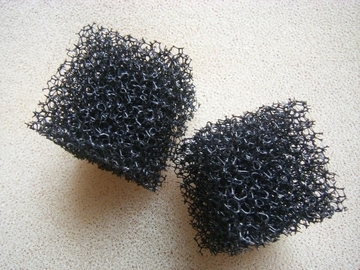
Reticulated polyurethane foam is a porous, lightweight solid foam, with few intact bubbles or cell windows. It is commonly used in filters, fuel tank inserts, and loudspeaker covers.
We want to apply a regular, flexible membrane to the edge surfaces of reticulated polyurethane foam pieces, approximately 100mm x 100mm squares and 100mm diameter rounds with a height of 25mm. The membrane must be thin (less than 0.25mm in thickness), permeable, and flexible. The foam and frame should be able to be compressed and allowed to recover to the original shape and resistant to water without the membrane detaching. See the video included here and the attached photo under "Additional Materials" at the bottom of this page, showing an example membrane.
In the video, note how the edge must remain intact through application of a water based slurry and being squeezed.
NOTE: We want to apply a regular, flexible membrane to the edge surfaces (not the top or bottom – see attached photo) of reticulated foam pieces.
Help us determine what a membrane should consist of, and how it should be applied. Specifically:
- What material should the membrane be made of? Remember, it must be thin, permeable, flexible and easily attached to the reticulated polyurethane foam.
- Describe the application process to put a membrane on the foam. What equipment, tools, or expertise would be needed to reproduce this process at a high volume, for example 1000+ units per day?
Include a diagram, rendering, image, or other visual to illustrate your concept.
NOTE: Your concept should be capable of industrialization so that high volumes of foams can be processed at low cost. Submissions will be accepted that fulfill the complete challenge OR only address one of the deliverables defined as points 1 or 2 above.
-
Submissions will be graded on the following criteria:
- Meets Deliverables
- Creativity
- Clarity
will share $1,000
will share $400
will share $200
| $250.00 |

|
Kat Claar University | |
| $250.00 |

|
Alvin Chang University of California at Davis | |
| $250.00 |

|
ashwin sancheti University of Akron | |
| $250.00 |

|
Josh Lyman University of Oregon | |
| $80.00 |

|
Jesse Lu University of California at San Diego | |
| $80.00 |

|
Gabriel Perez Putnam Swarthmore College | |
| $80.00 |

|
Ansh Tayal National Institute of Technology Trichy | |
| $80.00 |

|
ANAS ELSABAGH University of Waterloo | |
| $80.00 |

|
Akshat Gandhi University of Mumbai | |
| $25.00 |

|
Matthew Gaiser Queen's University | |
| $25.00 |

|
Keiko Shikanai Raritan Valley Community College | |
| $25.00 |

|
Stephanie Little Colorado Technical University | |
| $25.00 |

|
Dr. Janelle Christine Simmons Liberty University | |
| $25.00 |

|
Marwan Ahmed German University in Cairo | |
| $25.00 |

|
Aravind Samudrala Ravi University of South Florida | |
| $25.00 |

|
Chase Nicholson Georgia Institute of Technology | |
| $25.00 |

|
Kate Williams Central Piedmont Community College |
